
Il y a quelques temps, je suis ressortie de ce restaurant coréen en vous disant sur Twitter que je venais de manger le meilleur bibimbap de tous les temps (et qu’il avait été tellement bon que j’ avais oublié de le prendre une photo !… Ah la gourdasse !).
Erreur réparée, je suis retournée sur ce lieu de sustentation (plusieurs fois même, j’avoue !) avec le plus grand des plaisirs, pour vous partager cette adresse qui jusqu’à présent, me semble être la meilleure coréenne que j’ai testée.
A while back, I walked out of this korean restaurant and told you on Twitter I had just eaten the best bibimbap of all times (and that it was so good, I had forgotten to take a picture!…shame on me!!!).
I righted the wrong and went back (more than once, I’ll admit!) with the greatest of pleasures, and can now share this address with you, that, up to now, seems to me to be the best of koreans I have ever been to.
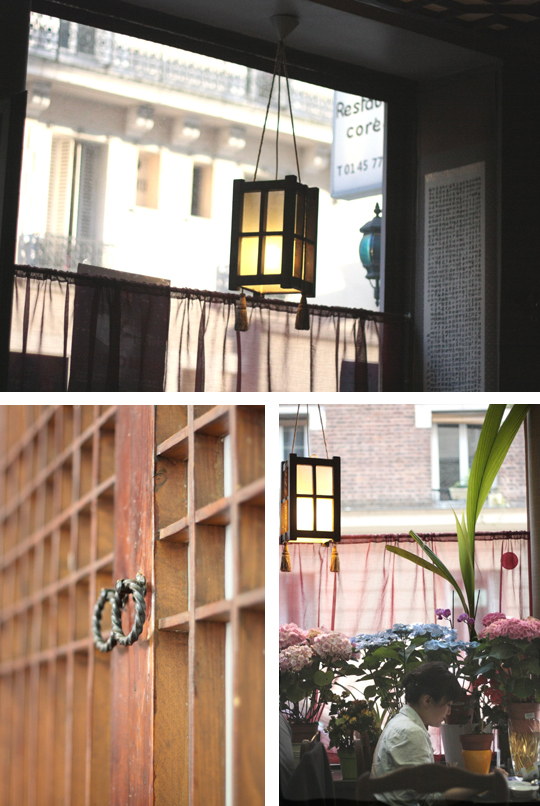
Je suis tombée par hasard sur ce restaurant en me baladant le long de la ligne 6 du métro . A l’intérieur, il n’y avait que des coréens attablés… et servis par des coréens ! Pas d’hésitation dans ce cas là, l’adresse semble être ce qu’il y a de plus authentique ! La carte propose une multitude de plats coréens traditionnels, certains sortant des sentiers battus.
Pour changer du classique bibimbap à la viande, j’ai choisi celui aux huîtres (il existe aussi le bibimbap aux fruits de mer mais je le goûterai la prochaine fois !). Il arrive devant nous, fumant, crépitant dans son bol en pierre (appelé « Dolsot »= instant « culture » permettant d’élargir son vocabulaire et caser de nouveaux mots au Scrabble). Pour ceux qui ne connaissent pas, le bibimbap est un mélange de riz, de légumes sautés, de viande (ici d’huîtres) : la recette est modulable à volonté. La sauce pimentée est servie à part pour s’adapter aux différentes papilles.
I found the place totally randomly, as I was strolling along the metro’s Line 6. Inside, there were only koreans seated, and the service was also exclusively korean! No hesitation in that kind of situation, the address seems to be as authentic as can be! The menu offers a large array of traditional korean dishes, some of which are clearly not common.
To vary from the classical bibimbap with meat, I went for the one with oysters (there’s also a seafood bibimbap, but I’ll try it next time!). And it is set before us, fuming and sizzling in it’s stone bowl (called Dolsot = the cultural moment of the day, that will allow us to both widen our vocabulary and learn new words for Scrabble). For those of you that might never have heard of it before, the bibimbap is a mix of rice, sauteed vegetables, meat (here, oysters): the recipe can be endlessly adapted. The hot pepper sauce is served on the side, to suit all palates.
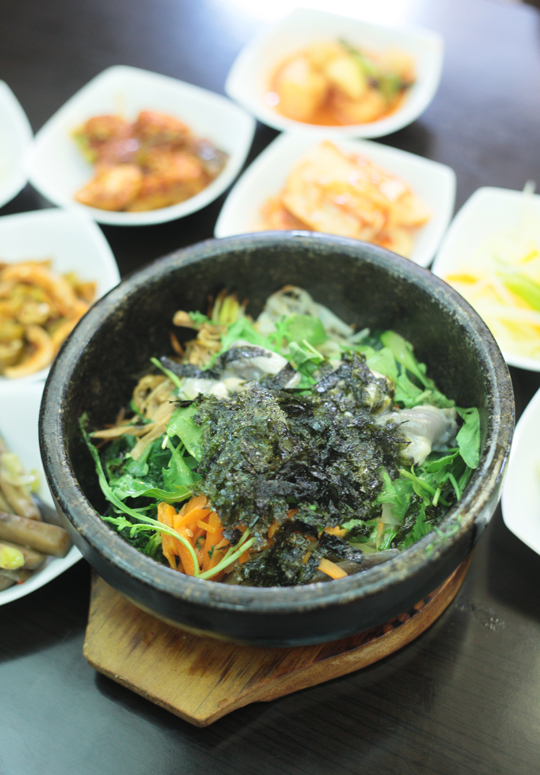
Alors pourquoi ai-je annoncé que c’était l’un des meilleurs (sinon le meilleur) que j’avais goûté ? Parce qu’ il est arrivé chaud bouillant (et que malheureusement ce n’est pas partout que ça arrive), que les ingrédients étaient d’une fraîcheur à tout épreuve, se mélangeant entre eux avec perfection, rehaussant le goût de l’huître et qu’au fond, le riz était grillé divinement. Exquis.
Si le bibimbap ne vous branche pas trop (comment cela est-il possible, malheureux !), vous pouvez opter pour les barbecues, comme ces tranches de poitrine de porc grillées. Là aussi, à tomber par terre. Les tranches de viandes sont apportées avec un assortiment de petites assiettes de légumes. On nous explique comment il faut procéder pour manger dans les règles de l’art.
So why did I start off saying it was one of the best (if not the best) I had ever tasted? Because it arrived boiling hot (and that unfortunately doesn’t happen everywhere), because the ingredients were impecably fresh, and mixed togethed perfectly, enhancing the oysters, and that at the very bottom, the rice was wonderfully roasted. It was divine.
If you’re not really into bibimbap (though how could this be??), you could opt for the barbecue, like those slices of grilled bacon. Here too, they are exquisite. The slices of meat are served with an assortment of small plates of vegetables. There’s also an explanation on how to eat according to the state of the art.
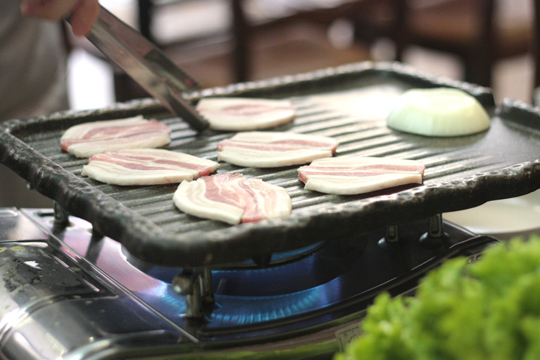
Prendre une feuille de salade, y placer une feuille d’algue séchée, une pointe de pâte de soja fermenté, la tranche de porc grillée au préalable sur la plaque et y ajouter les légumes par ci par là (kimchi (=chou chinois fermenté pimenté), germes de soja, aubergines…) afin de s’en « rouler une ». Peace man !
Take a lettuce leaf, place some Nori on it, a bit of fermented bean paste, a slice of grilled bacon, and add a couple of vegetables here and there (kimchi (=fermented and spicy chinese cabbage), bean sprouts, eggplant…) and roll it up. Peace man!
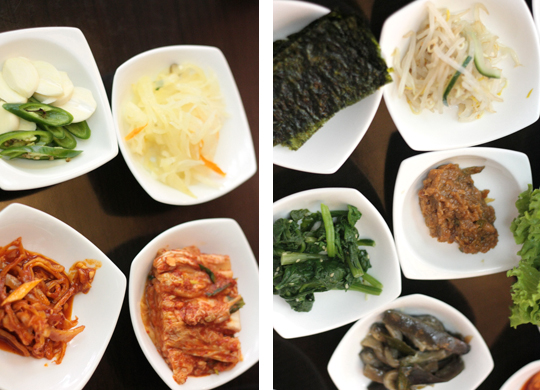
Il n’y a plus qu’à déguster le rouleau de salade bien garni, enveloppé par nos soins et on savoure. Exquis (bis !). C’est fondant, croustillant, relevé et doux : le plat idéal lorsque l’on veut partager à plusieurs un repas en toute convivialité.
And now you just have to enjoy that well garnished salad roll. Exquisite (bis!). It’s soft yet crispy, spicy yet mild: the perfect dish when you want to share a meal in a friendly and relaxed atmosphere.
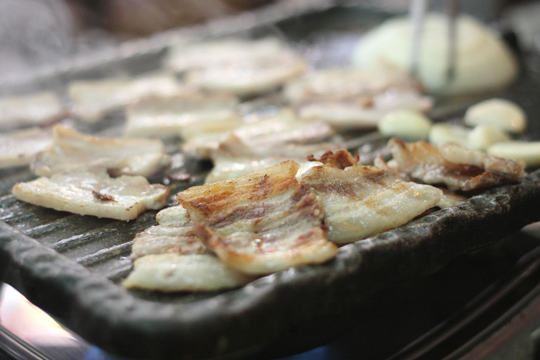
Voici quelques autres plats que j’ai pu tester : Le Samgyetang : une soupe de poulet au ginseng. Le plat se suffit à lui-même car attention ! Le poulet est farci de riz gluant. Encore une fois un plat qui arrive bouillant sur la table, promesse d’un moment délicieux et réconfortant.
Here are a few of the dishes I tried: The Samgyetang : a ginseng chicken soup. The dish is enough on its own, for beware!! The chicken is stuffed with sticky rice. Once more, the dish arrives boiling hot on the table, the promise of a delicious and comforting moment.
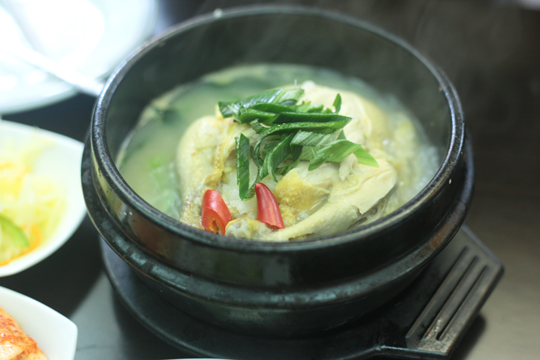
Le riz chaud aux céréales : ce que nous avions pris en accompagnement avec le barbecue mais nous avons vu un peu large car le barbecue suffit amplement pour de bons appétits. Le serveur nous a donc proposé d’en ramener à la maison (Chance !).
Hot rice with cereals: this is what we had as side dish with the barbecue, but we were a bit too ambitious, for the barbecue was quite enough for large appetites. Which is probably why the server offered us a doggy-bag (Lucky us!)
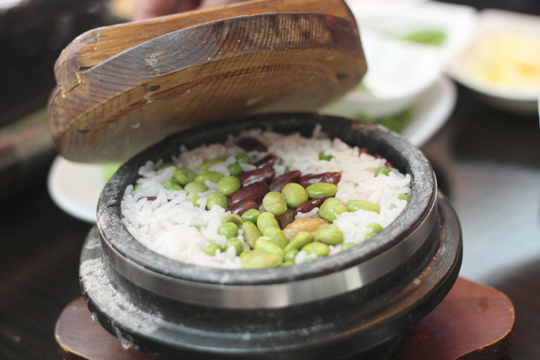
Le porc sauté au tofu et kimchi : Une entrée pimentée délicieuse. The sauteed pork with tofu and kimchi : a spicy and delicious starter.
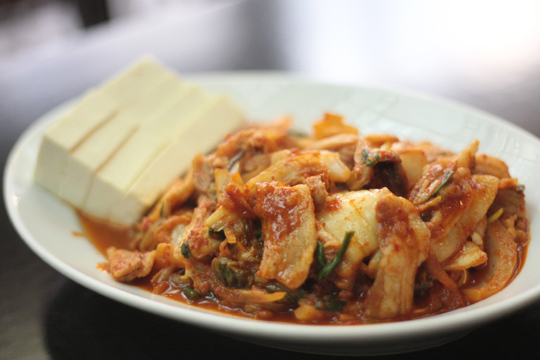
Voilà donc mon adresse coréenne préférée dévoilée au grand jour qui va, je sens, réchauffer ces futures journées glaciales d’hiver…Bon appétit !
So there we are: here is my favorite korean address, which I think, will warm up those future ice cold winter days…Enjoy!! (English translation by Bleu Marine)
Restaurant DAWA
5 rue Humblot
75015 PARIS
(Métro Dupleix)














